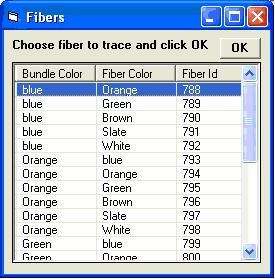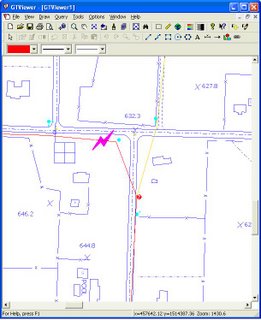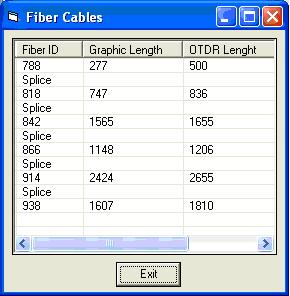Join us at the 2006 Smallworld Americas Users Conference, September 24-27. This year the conference returns to the attractive Omni Interlocken Resort near Denver, Colorado.
GTI will be showing its configurable data collection application GT/Field, the new GTWeb 5.0, and the rest of the GTViewer Family of Products that help companies gain more value from their geospatial data.
GTI will also be showing its solutions including the new Fiber OTDR Trace application that allows a field technician to find the location of breaks and splice problems. Come see Loop Makeup, Gas Valve Isolation, Outage Analysis, and more.
Thursday, August 17, 2006
Tuesday, August 15, 2006
GTVx version 5.0.x.8 is Available
Version 5.0.x.8 of GTVx is available.
-----------------------
05.00.00.08 - 08/15/06
-----------------------
- NEW - Right Mouse Cancel is now supported during rendering.
- FIX - The .GTS session files did not correctly save Leader Line elements.
- NEW - Shape with Holes elements now supported styled lines for their borders.
- FIX - Connectivity Query and Offset Query would not find a record if it were the first record in the file. Problem introduced with very large .gtx file support was enhanced (4.0.0.6).
Monday, August 14, 2006
GTRead version 5.0.0.2 is Available
GTRead is a Windows ActiveX Control that reads GTViewer graphics files (.gtg) and Extract files (.gtx). GTRead is part of the GTViewer-SDK and can be used to add the cability of reading GTViewer data into any application as long as the development platform supports ActiveX controls.
Version 5.0.0.2 of GTRead uses the GTViewer 5.0 core and contains several fixes.
Version 5.0.0.2 of GTRead uses the GTViewer 5.0 core and contains several fixes.
New GTData Tools
The next version of GTData will contain 3 new utilities: GTTabImport, GTMergeStyles, and GTStyleMgr.
GTTabImport provides a method to import custom changes from one Table Definition Files (.tab) file into another. Custom changes include alternate table names, alternate attribute names, display order of tables, and display order of attributes. The Table and/or Attribute must exist in the main .tab file before it will be imported from the import file. The GTConfig.exe utility has the capability to import custom changes from one .tab file to another, but it has a GUI and could not be run on the command-line or in scripts. The GTTabImport utility takes this feature of GTConfig.exe and makes it scriptable.
GTMergeStyles provides an easy method for merging multiple style.def and style.map files together. This task could be performed by the Style Manager in GTViewer; however, with this utility, the process can be scripted.
GTStyleMgr provides several new features for manipulating Style Rules (style.def and style map files). The features it provides are listed below:
GTTabImport provides a method to import custom changes from one Table Definition Files (.tab) file into another. Custom changes include alternate table names, alternate attribute names, display order of tables, and display order of attributes. The Table and/or Attribute must exist in the main .tab file before it will be imported from the import file. The GTConfig.exe utility has the capability to import custom changes from one .tab file to another, but it has a GUI and could not be run on the command-line or in scripts. The GTTabImport utility takes this feature of GTConfig.exe and makes it scriptable.
GTMergeStyles provides an easy method for merging multiple style.def and style.map files together. This task could be performed by the Style Manager in GTViewer; however, with this utility, the process can be scripted.
GTStyleMgr provides several new features for manipulating Style Rules (style.def and style map files). The features it provides are listed below:
- The Chop option can be used to remove a string from the beginning of a style definition name (both in the .def and .map files). Some of the conversion tools (like the G/Tech converter, and the FME plug-ins) use filter id names that match style definition names. It is possible to create your filter id name/style name with a prepended string that is useful for the filter name, but not necessary for the style (since the style could be reused by several different filter ids). The chop option will simply remove this prepended string from the style definition names leaving the filter ids intact.
- The Strip option can be used to remove a square bracket enclosed string ( […] ) at the end of a style definition name. The style definition name will be updated in both the style.def and style.map files. This option is useful in a specific case where a features state (in service, proposed, retired, etc.) is appended to the filter id and style name. It may be useful to control the display of features by state, but they may not use different style definitions. The Strip option will remove the bracketed name in the style.def and style.map.
- The Thin option is a replacement for a previous tool called GTStyleThinner which looked at all definitions in the style.def and deleted any definitions that were not referenced in the style.map. This process of thinning the style defs can reduce the overall size of the style rules in a dataset (sometimes important on the device platforms).
- The Fill option can be used to populate only the empty style definitions in a style.def from another style.def file.
- The Import option can be used to import another style definition file. This option works identically to the Import Option in GTViewer when the import only if exists command it used. Therefore, only styles that already exists (empty or not) in the original style.def will be imported.
Thursday, August 10, 2006
Fiber OTDR Trace Application for GTViewer
Fiber optic cable is no longer limited to communications and/or cable companies. Many electric companies have run fiber along their networks. Existing structures used to support the electric networks make power companies well poised for providing communication services for internal purposes or to compete with traditional communication companies. With the increasing use of Fiber, one application that many users have asked for in GTViewer is a Fiber OTDR Trace. This application is an excellent example of how GTViewer can really leverage the data from your GIS to provide a truly productivity-enhancing tool for the field.
OTDR (Optical Time Domain Reflectometer) is a device that analyzes the loss of light in fiber. This loss could be caused by a break in the fiber or by splice problems. The device simply pulses a laser into the fiber and precisely measures the time between emission and detection of the backscatter created by problems along the fiber path. The device then provides a distance to the location of the problem.
Using GTViewer and GT/Trace, the Fiber OTDR Trace application allows the user to graphically select the feature where the OTDR is attached to the fiber network.

Then based on the selected Terminal or Splice, the application will guide the user to select a specific fiber to trace:


With the distance to the problem from the OTDR, the Terminal or Splice ID, and the Cable Id, the application is ready to find the problem.


By tracing the specific fiber through the network, a list of features is produced and a tally of both the graphical lengths (as drawn on the map) and OTDR lengths (from the database). Then by interpolating the distance to the problem indicated by the OTDR, a precise location can be graphically indicated on the map in GTViewer along with the graphical trace results.
A report of all features traversed to get to the problem can also be displayed:

GTViewer empowers the users with the information necessary to resolve the fiber problem. While the OTDR provides the critical piece of information about the location of the problem, only tracing the fiber network for a specific fiber can get you to the right spot. Traditionally, the OTDR trace could only be performed by a full GIS seat in an office environment. Now, GTViewer and the Fiber OTDR Trace application give you the tools you need when and where you need them.
OTDR (Optical Time Domain Reflectometer) is a device that analyzes the loss of light in fiber. This loss could be caused by a break in the fiber or by splice problems. The device simply pulses a laser into the fiber and precisely measures the time between emission and detection of the backscatter created by problems along the fiber path. The device then provides a distance to the location of the problem.
Using GTViewer and GT/Trace, the Fiber OTDR Trace application allows the user to graphically select the feature where the OTDR is attached to the fiber network.

Then based on the selected Terminal or Splice, the application will guide the user to select a specific fiber to trace:


With the distance to the problem from the OTDR, the Terminal or Splice ID, and the Cable Id, the application is ready to find the problem.


By tracing the specific fiber through the network, a list of features is produced and a tally of both the graphical lengths (as drawn on the map) and OTDR lengths (from the database). Then by interpolating the distance to the problem indicated by the OTDR, a precise location can be graphically indicated on the map in GTViewer along with the graphical trace results.
A report of all features traversed to get to the problem can also be displayed:

GTViewer empowers the users with the information necessary to resolve the fiber problem. While the OTDR provides the critical piece of information about the location of the problem, only tracing the fiber network for a specific fiber can get you to the right spot. Traditionally, the OTDR trace could only be performed by a full GIS seat in an office environment. Now, GTViewer and the Fiber OTDR Trace application give you the tools you need when and where you need them.
Subscribe to:
Posts (Atom)
